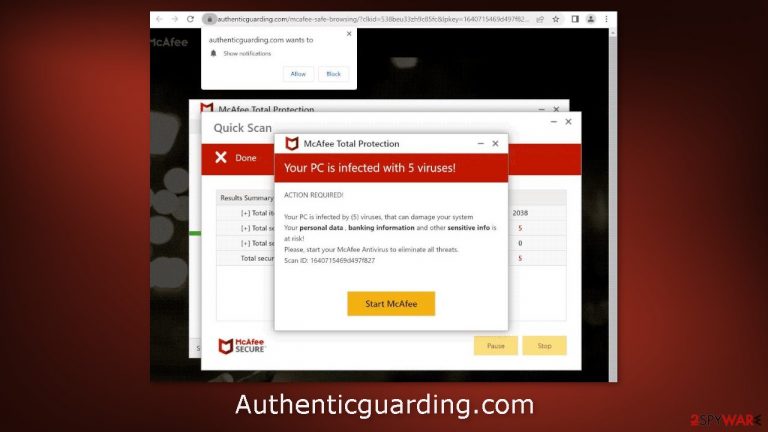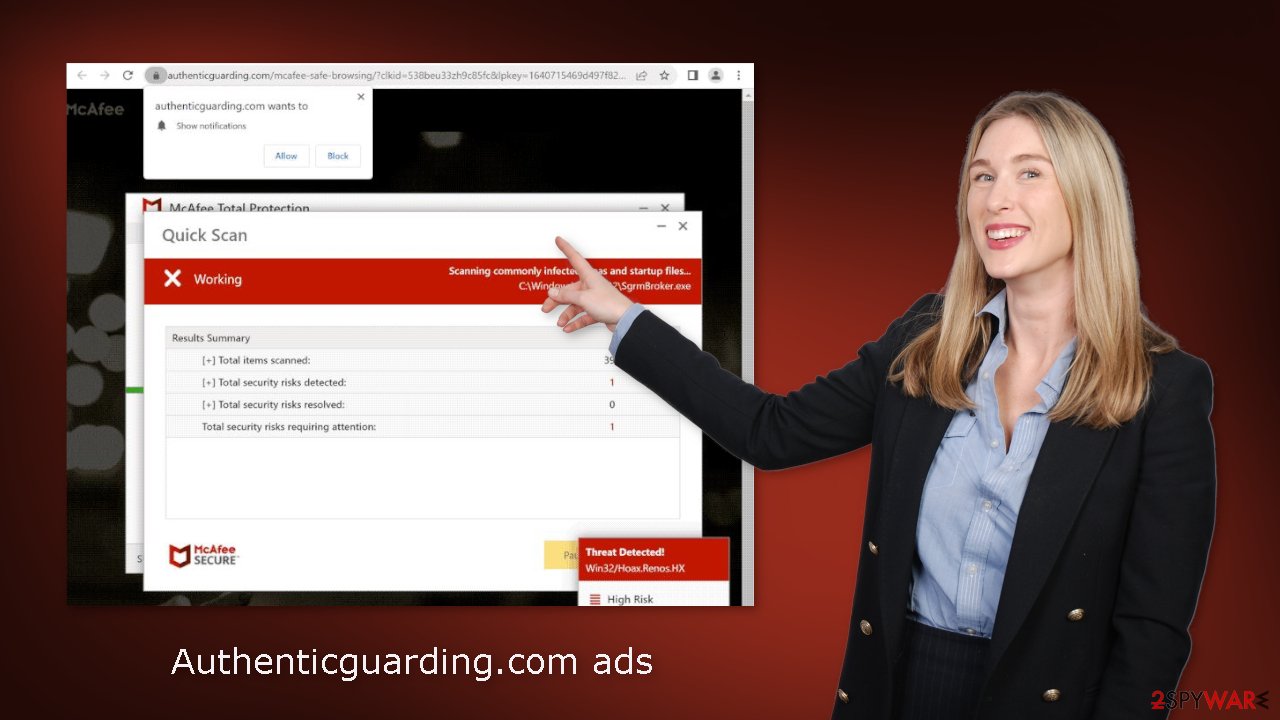Authenticguarding.com ads (fake) - Free Instructions
Authenticguarding.com ads Removal Guide
What is Authenticguarding.com ads?
Authenticguarding.com pretends to warn users about a system infection that does not exist

Authenticguarding.com is a fake website designed by scammers to appear as a legitimate security alert from McAfee. Its purpose is to deceive people into believing that their system is at risk and redirect them to the official McAfee website. The scammers behind this fraudulent campaign aim to make money through the affiliate program, earning a commission for every subscription purchased.
Additionally, the website may also generate pop-up spam and push notifications that mimic security alerts. These notifications may be delivered through rogue advertising networks[1] that may lead users to dangerous websites, where they may be prompted to provide personal information, download PUPs (potentially unwanted programs),[2] or even malware. These websites may advertise adult content, fake software deals, giveaways, surveys, and other deceptive offers.
| NAME | Authenticguarding.com |
| TYPE | Push notification spam; adware |
| SYMPTOMS | A page appears seemingly out of nowhere warning users about virus infections; users may start seeing pop-ups that look like security alerts; |
| DISTRIBUTION | Shady websites; deceptive ads; bundled software |
| DANGERS | People may be tricked into providing personal information, downloading potentially unwanted programs, or even malware |
| ELIMINATION | Disable push notifications in the browser settings; run a system scan with professional security tools |
| FURTHER STEPS | Use FortectIntego to fix any remaining damage and optimize the machine |
Distribution methods
To protect yourself from websites like Authenticguarding.com, it's important to only visit pages that you know and trust. Avoid clicking on random links and ads, even if they appear to offer legitimate products or services. It's also a good idea to choose legitimate streaming platforms over illegal streaming websites,[3] as these sites may have fake “Download” or “Play” buttons that lead to scam sites.
Pages created by crooks often mimic legitimate websites or brands in order to trick people into believing that they are safe to visit. These sites may use various tactics to lure users in, such as offering fake deals, promoting fake products, or claiming to have important information or alerts.

How to disable pop-ups?
To stop annoying virus alerts from Authenticguarding.com, you have to block the site permissions that allow it to show you push notifications. You can do that by following our step-by-step guide:
Google Chrome (desktop):
- Open Google Chrome browser and go to Menu > Settings.
- Scroll down and click on Advanced.
- Locate the Privacy and security section and pick Site Settings > Notifications.

- Look at the Allow section and look for a suspicious URL.
- Click the three vertical dots next to it and pick Block. This should remove unwanted notifications from Google Chrome.

Google Chrome (Android):
- Open Google Chrome and tap on Settings (three vertical dots).
- Select Notifications.
- Scroll down to Sites section.
- Locate the unwanted URL and toggle the button to the left (Off setting).

Mozilla Firefox:
- Open Mozilla Firefox and go to Menu > Options.
- Click on Privacy & Security section.
- Under Permissions, you should be able to see Notifications. Click Settings button next to it.

- In the Settings – Notification Permissions window, click on the drop-down menu by the URL in question.
- Select Block and then click on Save Changes. This should remove unwanted notifications from Mozilla Firefox.

Safari:
- Click on Safari > Preferences…
- Go to Websites tab and, under General, select Notifications.
- Select the web address in question, click the drop-down menu and select Deny.

MS Edge:
- Open Microsoft Edge, and click the Settings and more button (three horizontal dots) at the top-right of the window.
- Select Settings and then go to Advanced.
- Under Website permissions, pick Manage permissions and select the URL in question.
- Toggle the switch to the left to turn notifications off on Microsoft Edge.

MS Edge (Chromium):
- Open Microsoft Edge, and go to Settings.
- Select Site permissions.
- Go to Notifications on the right.
- Under Allow, you will find the unwanted entry.
- Click on More actions and select Block.

Clear cookies from your browser
Cookies are small text files that are placed on your computer or device when you visit a website. They can track your online activity and store information such as your IP address, geolocation, websites visited, links clicked, and purchases made. This data is often used to personalize the user experience, but it can also be sold to advertising networks and other third parties by scammers seeking to profit from it.
Cookies can also be hijacked and used for malicious purposes, which is why it's recommended to clear them regularly. This can be easily done with the help of a maintenance tool like FortectIntego, which can also fix various system errors, corrupted files, and registry issues, especially useful after a virus infection.
Scan your machine with anti-malware tools
If you have disabled push notifications but are still experiencing unwanted symptoms such as unexpected redirects, an increase in commercial content like pop-ups and banners, it is possible that your system may be infected with adware. In this case, it is recommended to scan your system for potentially unwanted programs (PUPs) and remove them using trusted professional security tools like SpyHunter 5Combo Cleaner or Malwarebytes. These tools are designed to detect and remove most suspicious apps, ensuring that they are completely removed from your system.
While it is possible to remove PUPs manually, it can be difficult to determine which particular app is causing the unwanted behavior as scammers often disguise them as useful tools. Additionally, manual uninstallation may leave behind traces of the program that could result in the infection being reinstated.
If you prefer not to use security tools and know which program is causing the issue, you can try manually uninstalling it using the following steps:
Windows 10/8:
- Enter Control Panel into Windows search box and hit Enter or click on the search result.
- Under Programs, select Uninstall a program.

- From the list, find the entry of the suspicious program.
- Right-click on the application and select Uninstall.
- If User Account Control shows up, click Yes.
- Wait till uninstallation process is complete and click OK.

Windows 7/XP:
- Click on Windows Start > Control Panel located on the right pane (if you are Windows XP user, click on Add/Remove Programs).
- In Control Panel, select Programs > Uninstall a program.

- Pick the unwanted application by clicking on it once.
- At the top, click Uninstall/Change.
- In the confirmation prompt, pick Yes.
- Click OK once the removal process is finished.
Mac:
- From the menu bar, select Go > Applications.
- In the Applications folder, look for all related entries.
- Click on the app and drag it to Trash (or right-click and pick Move to Trash)

To fully remove an unwanted app, you need to access Application Support, LaunchAgents, and LaunchDaemons folders and delete relevant files:
- Select Go > Go to Folder.
- Enter /Library/Application Support and click Go or press Enter.
- In the Application Support folder, look for any dubious entries and then delete them.
- Now enter /Library/LaunchAgents and /Library/LaunchDaemons folders the same way and terminate all the related .plist files.

How to prevent from getting adware
Choose a proper web browser and improve your safety with a VPN tool
Online spying has got momentum in recent years and people are getting more and more interested in how to protect their privacy online. One of the basic means to add a layer of security – choose the most private and secure web browser. Although web browsers can't grant full privacy protection and security, some of them are much better at sandboxing, HTTPS upgrading, active content blocking, tracking blocking, phishing protection, and similar privacy-oriented features. However, if you want true anonymity, we suggest you employ a powerful Private Internet Access VPN – it can encrypt all the traffic that comes and goes out of your computer, preventing tracking completely.
Lost your files? Use data recovery software
While some files located on any computer are replaceable or useless, others can be extremely valuable. Family photos, work documents, school projects – these are types of files that we don't want to lose. Unfortunately, there are many ways how unexpected data loss can occur: power cuts, Blue Screen of Death errors, hardware failures, crypto-malware attack, or even accidental deletion.
To ensure that all the files remain intact, you should prepare regular data backups. You can choose cloud-based or physical copies you could restore from later in case of a disaster. If your backups were lost as well or you never bothered to prepare any, Data Recovery Pro can be your only hope to retrieve your invaluable files.
- ^ Zeljka Zorz. How does a rogue ad network function?. Helpnetsecurity. Information Security Blog.
- ^ Wendy Zamora. What is a PUP? – How to avoid potentially unwanted programs. Malwarebytes. Tips, Tricks, and How-Tos.
- ^ Brittni Devlin. Why Should You Avoid Illegal Streaming Sites?. Makeuseof. Security Blog.
